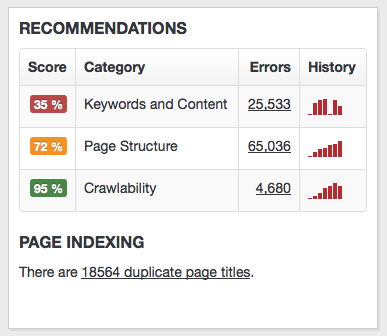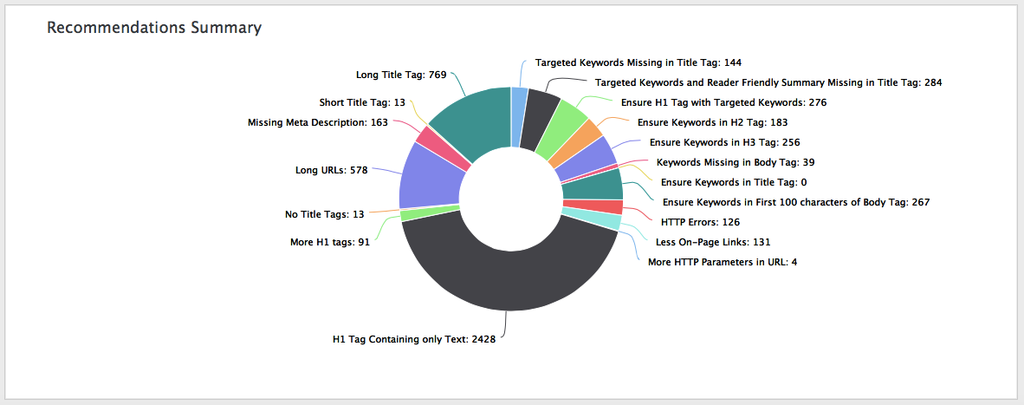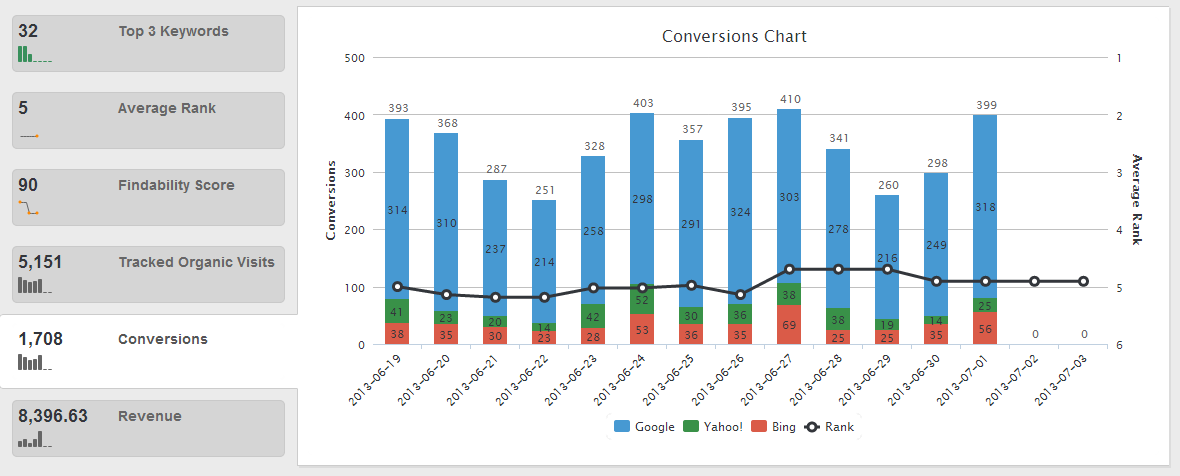Organic search is still the number one source of website traffic for organizations and nearly 90% of organizations are using content marketing to engage audiences and create conversions. The need for consistent and strategic SEO has never been greater, especially with the recent changes in local and mobile. Yet, in some organizations, SEO is not the top priority. While trying to improve rankings and beat the competition, organizations are simultaneously putting SEO recommendations on the back burner.
For SEOs who are frustrated and tired of creating reports and recommendations that are never fully implemented, knowing how to prove SEO success will help make it a priority.
SEO de-prioritization

Although it might feel like your SEO recommendations and reports are being ignored, it’s more likely that they have fallen somewhere lower on the list of priorities than you’d like. For the people actually responsible for making the changes, they may feel there are more interesting, exciting, and maybe urgent tasks to perform, like creating content. This is obviously a mistake, and I don’t need to tell anyone in SEO why content creation shouldn’t be a shot in the dark, but we’ll get back to that.
“When there’s a disconnect with the overall importance of search and SEO inside an organization, it could be a de-prioritization on the scale of things, like where people spend time and budget, But I think SEO and the information gathered from search, in general, has implications beyond just how it impacts the marketing stack,” states Erin O’Brien, President and COO.
When shared with the right people, and in the right way, SEO data can have far reaching implications in an organization, including informing future product development and new feature releases. When shared with the product development team, SEO can give insight into:
- How people are talking about your industry.
- How they’re naturally searching for features.
- What conversations they’re having and questions they’re asking.
- How they’re describing their problems.
- How language used to talk about the industry is changing over time.
- What new key players have entered the market.
Using this information, brands can get a deeper understanding of core issues, how those issues are changing and evolving over time, and how the changes in the market can inform changes or additions to the product line.
Show success with an SEO pilot program
Everyone loves a success story. Especially the C-suite and especially when the success story shows a contribution to the bottom line. To move SEO from the middle of the priority list and put it top of mind for the decision makers in your organization, try establishing a small test case through a pilot program.
Narrow your SEO focus to a particular campaign or product within the company to demonstrate the importance and the impact of SEO. A pilot program will help to narrow down the scope of work and show positive results in a very focused and easily digested way.
“Sometimes the list of SEO recommendations can be an extremely daunting thing, especially if you’re starting the a site and content audit and you get a list of 10,000 recommendations. A pilot program is a way to narrow the number of recommendations you’re dealing with to a manageable size and a way to compare the small group of things you’ve optimized against other content,” notes Erin.

Even in a small team, or if you don’t have a dedicated SEO department, SEO pilot programs can be started adjacent to other marketing programs and used as a benchmark to compare results of those efforts that employ good SEO practices, versus those that are business as usual.
Show immediate SEO results
If you’re going to prove the success of SEO, you’ll want to start with the quick fixes that show immediate results. A good place to start is with optimizing page structure. Whether you’re creating new content, or going back to improve the findability of older content, the page must be built correctly to get preferred SERP results. Some easy fixes for page structure include:
- Optimize H1 tags to include only text.
- Ensure that there is only one H1 tag per page.
- Include a unique title tag.
- Longer than 5 characters
- Shorter than 55 characters
- Include a unique meta description.
There are other, more difficult, fixes that affect page structure and crawlability including URL length, redirects, 404 errors, and duplicate page titles that require someone with technical coding knowledge to tackle. While some optimizations wax and wane in importance, you’ll want to make sure the content throughout your site has a structure easily crawlable by search engines. Page structure and crawlability improvements produce increased overall findability and better ranking for content that might otherwise get passed over by the search bots because it’s not structured well.
Small organizations and large organizations have their own unique roadblocks to consistently creating pages with good page structure and crawlability. In small organizations, there may be just a few people cranking out content and creating web pages. Typically, they’re in a hurry to complete the task at hand and don’t take the time to consider search best practices, or intend to go back and put in meta tags, descriptions, and other elements later. Because of the nature of working in a small organization, there is always another task or distraction and those things people intent to go back to get lost and forgotten in the priority list. The problem remains, limited time and resources have been spent creating something that won’t get the leverage it could if it had been structured correctly in the first place.
In a large organizations, communicating SEO ground rules to all the people within the organization who may be contributing to content creation is a roadblock to unified SEO practices.
SEO templates – a pyramid of priorities
SEO templates are a great way to communicate the SEO best practices and basics that everyone in the organization must follow. One way to visualize those priorities is a pyramid structure where the most basic and required SEO practices are at the bottom and gradually topping the pyramid are the SEO considerations that could be placed lower on a priorities list, or something to come back to later. At the bottom of the pyramid are basic SEO elements such as meta tags and meta descriptions, all the absolute critical page structure optimizations.
Keep SEO top of mind with everyone by creating a one-page SEO template and placing it on the desk of anyone who creates content. Of course, creating something and distributing it once is not enough. You’ll have to continue to revisit individuals, or teams, to remind them how good SEO can help achieve more success.
Starting with some basic SEO best practices can have a cascading effect with the entire site and content mix showing improved findability and crawlability as a result.
“Selling” SEO in your organization
Anyone working at a business with a web presence recognizes that SEO has some value. The hard sell for many SEO departments is getting the attention and resources needed to not only inform and improve website and off site content, but also impact the entire life cycle of the product. Organic traffic data can have far reaching influence that begins at product idea, through marketing, and all the way through sales conversion to customer happiness.
SEO departments should communicate their worth, not just as a way to know what people are looking for and how to get more page views, but also as a predictive tool for organizations to understand:
- How to create better conversions
- How to attract a more relevant audience
- How to facilitate better customer satisfaction
- What questions prospects are asking
- What questions current customers are asking
“SEO has value beyond just getting more traffic to a website. Sometimes, the data collected can be an early warning system that customers have ongoing problems or concerns and are looking for answers outside of your website. If you aren’t addressing their questions, your competitor may be. Creating keyword and content groups around customer types will help you monitor those interactions,” notes Erin.
Keyword and content groups can be created for a variety purposes, including tracking:
- Campaigns
- Personas
- Geographies
- Products
- Features
- Sales funnel (customer journey)
Once you have data bucketed by groups, it’s easy to sell SEO to various departments within the organization:
- Share it as research for the customer success team
- Give it to the sales team to use in email subject lines
- Show marketing where they can fill content holes
- Use it to help the product development team to understand market opportunities
Establishing a practice of making SEO data useful to many different departments will have the effect of it selling itself over time. Knowing how to talk to different people in the organization, what sort of data to present, and how to present it in a way that’s immediately useable is probably one of the best ways to get buy-in for SEO prioritization within your organization.
When we talk about making SEO a priority in your organization and we talk about speaking the language of the people who have influence over what is prioritized, we can’t overlook the C-Suite. When you’re talking to the C-Suite, tie your efforts and results into the overall corporate goals. You’ll want to show how improved rank actually works better or creates better conversions.

If you’ve ever been in a situation where someone in the organization points to a competitor and says, “Why aren’t we doing what the competitor is doing?”, you know how frustrating being compared to other people’s efforts can be. However, SEO departments can turn the tables and use that same tactic to bring SEO to the forefront. For instance, if some content competitor or product competitor is always outranking you, it might be a good time for the SEO department to ask “why?”. If you’re using the same keywords, and talking about the same topics, but your competitors are outranking you, maybe it’s because you’re not optimized for SEO. That’s a good time for the SEO department to step in and make a case for getting recommendations prioritized. Just tell upper management that the competitors are doing it, and doing it better, that will get their attention.
When you’re talking to the C-Suite, you’ll want to tie SEO efforts to overall corporate goals. Here are some resources to get you started:
Or watch the Found Friday episode where we discuss how to make SEO succeed in your organization.

